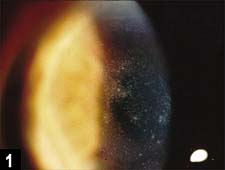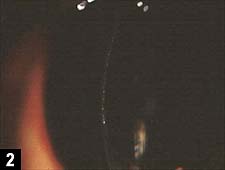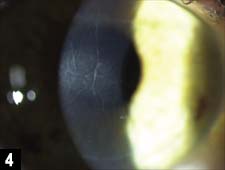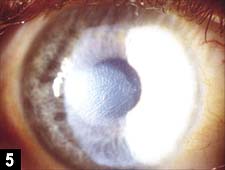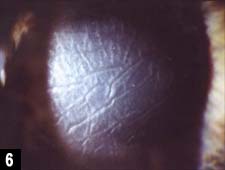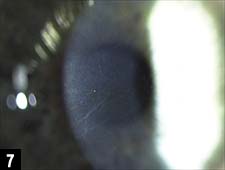Surgeon: Severe corneal lesions after LASIK are not stage 4 DLK
Click Here to Manage Email Alerts
LOS ANGELES — A severe white central lesion appearing on the cornea within the first few days following LASIK is often mistaken for stage 4 diffuse lamellar keratitis, according to a surgeon here.
Robert K. Maloney, MD, told Ocular Surgery News that what people are mistakenly calling stage 4 DLK is actually not a form of DLK but a toxic reaction he has dubbed central toxic keratopathy.
According to Dr. Maloney, DLK manifests as a diffuse inflammation confined to the LASIK interface. It is marked by accumulation of inflammatory cells and can be effectively treated with steroids.
However, central toxic keratopathy (CTK) is focal rather than diffuse. It typically affects the central part of the ablation zone, is not confined to the interface and typically moves posteriorly into the stroma, often to the endothelium, he said.
“I think stage 4 DLK is a misnomer for this syndrome. Stage 4 DLK is confusing because a whitish lesion is produced following LASIK. CTK is not inflammatory. It is white in color because there appears to be some change in the keratocytes or the collagen. But there are no inflammatory cells,” he said.
CTK described
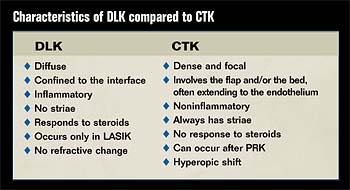 Dr. Maloney said he is not sure what causes CTK, but he believes it is a toxic effect on the cornea, possibly caused by photoactivation of Betadine (povidone-iodine 10%, Purdue Frederick) by the excimer laser, which creates damaging free radicals.
Dr. Maloney said he is not sure what causes CTK, but he believes it is a toxic effect on the cornea, possibly caused by photoactivation of Betadine (povidone-iodine 10%, Purdue Frederick) by the excimer laser, which creates damaging free radicals.
“But that’s purely a hypothesis,” he said. “Proving it would have to be done in an animal model. I am confident it has nothing to do with the microkeratome. In fact, it probably has nothing to do with the flap itself, but something toxic that gets on the cornea. I have had two cases of CTK following photorefractive keratectomy. That’s another reason I believe it is another entity than DLK. You never get DLK after PRK.”
Distinguishing between DLK and CTK can be confusing. In his experience, Dr. Maloney said CTK following LASIK has always been accompanied by DLK, and typically even begins as DLK. Then, typically on day 3 or day 4, a white lesion appears on the cornea.
“When it first shows up, you have coexistence of CTK with DLK. Then the inflammation subsides and you are left with the whitish CTK lesion. I think that’s another reason why the two entities are being confused,” he said.
Another feature distinguishing CTK from DLK is that DLK does not affect the patient’s refractive error because tissue is not added or subtracted. CTK, however, causes a marked hyperopic shift due to what appears to be necrosis and dissolution of the corneal tissue. Collapse of the collagen lamella occurs, which results in a hyperopic shift.
CTK is also characterized by marked striae in the flap, which appear as clear zones in the whitish opacity.
No treatment
The routine treatment for stage 1 and stage 2 DLK is frequent installation of topical steroids. Stage 3 DLK is usually treated by lifting the LASIK flap and irrigating the interface. However, Dr. Maloney said, CTK cannot be treated acutely.
“That’s very important because steroids do not work,” he said. “Steroids can’t work because there is no inflammation.”
Dr. Maloney warned treating patients with long-term steroids for CTK is a mistake because there is a risk of inducing glaucoma. He cited four cases he has published of patients treated with steroids for chronic DLK following LASIK. These patients went on to develop severe glaucoma.
“What happens is the pressure in the eye rises and patients develop fluid under the flap, which inhibits the accurate measurement of IOP. The pressure is elevated, but the measurement of that pressure is normal,” he said.
There is no point in lifting the flap and irrigating the interface because the lesion is not in the interface. However, during the phase where CTK is present and coexisting with DLK, it may be worth irrigating the cornea to treat the DLK, he said.
“But that will not help the CTK. Once you have it, you have it,” he said.
What can be done
Because there is no treatment for the disorder, prevention is key to its management. Dr. Maloney said surgeons should take precautions to ensure nothing potentially toxic, particularly Betadine, gets under the flap and recommended copious irrigation of the ocular surface before making the microkeratome cut.
Dr. Maloney has been using copious irrigation for about 3 years and has experienced no cases of CTK in that time.
He said there are a number of ways Betadine can be introduced to the ocular surface. After prepping the eye lids, instruments such as the microkeratome may touch the lids as surgery begins, or perhaps Betadine is unintentionally or intentionally irrigated into the cul-de-sac.
Whatever is the cause, Dr. Maloney said observation is the only treatment option once patients do develop CTK.
“In my experience, 6 to 9 months after the onset it always resolves and the cornea is clear again,” he said. “A hyperopic shift usually remains, but can be effectively treated with an enhancement.”
Dr. Maloney also recommends treating the striae at the time of the enhancement.
Having seen roughly 20 cases of CTK, he said every patient has eventually done reasonably well after enhancement.
|
|
|
|
|
|
|
|
|
|
|
For Your Information:
- Robert K. Maloney, MD, can be reached at Maloney-Seibel Vision Institute, 10921 Wilshire Blvd., Suite 900, Los Angeles, CA 90024; (310) 208-3937; fax: (310) 208-8058; e-mail: DrMaloney@MaloneySeibelVision.com.

